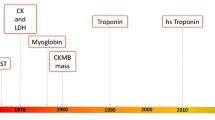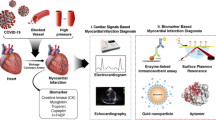Abstract
The C-reactive protein, Chlamydia-specific IgG antibody, and fibrinogen were assayed in the serum of 159 patients with arterial disease (the arterial group) and 203 patients with heart valve prostheses (the valvular group) and no demonstrable coronary disease. In the arterial group, the Chlamydia pneumoniae antibody was ≥1 : 32 for 67.3% (107/159) of the patients, the C-reactive protein was elevated in 41.5% (66/159), and the fibrinogen was elevated in 27.7% (44/159). In the valvular group, the C. pneumoniae antibody was ≥1 : 32 for 59.1% (120/203) of the patients; the C-reactive protein was elevated in 34.0% (69/203), and the fibrinogen was elevated in 17.2% (35/203). Of 107 patients in the arterial group with C. pneumoniae titers ≥1 : 32, only 26 (24.3%) had elevated fibrinogen (426 ± 29 mg/dL) and 44 (41.1%) had elevated C-reactive protein (1.06 ± 0.52 mg/dL). Similarly, of the 120 patients in the valvular group with C. pneumoniae titers ≥1 : 32, 17 (14.2%) had elevated fibrinogen (409 ± 29 mg/dL) and 34 had elevated C-reactive protein (0.99 ± 1.1 mg/dL). Correlated poorly was C. pneumoniae with C-reactive protein and fibrinogen levels. Only the fibrinogen level could be discriminated between the arterial and the valvular group. These results suggest that no causal association exists between inflammation and C. pneumoniae. A highly significant correlation between C-reactive protein and fibrinogen levels was found.
Similar content being viewed by others
REFERENCES
Ross, R. 1999. Atherosclerosis. An inflammatory diseases. N. Engl. J. Med. 340:115–126.
Maseri, A. 1997. Inflammation, atherosclerosis, and ischemic events. Exploring the hidden side of the moon. N. Engl. J. Med. 336:1014–1016.
Libby, P., D. Egan, and S. Skarlatos. 1997. Roles of infectious agents in atherosclerosis and restenosis. Circulation 96:4095–4103.
Danesh, J., R. Collins, and R. Peto. 1997. Chronic infections and coronary heart disease: Is there a link? Lancet 350:430–436.
Metha, J. L., T. G. P. Saldeen, and K. Rand. 1998. Interactive role of infection, inflammation and traditional risk factors in atherosclerosis and coronary artery disease. J. Am. Coll. Cardiol. 31:1217–1225.
Linnanmki, E., M. Leinonen, K. Mattila, M. S. Nieminen, V. Valtonen, and P. Saikku. 1993. Chlamydia pneumoniae-specific circulating immune complexes in patients with chronic coronary heart disease. Circulation 87:1130–1134.
Saikku, P., M. Leinonen, K. Mattila et al. 1988. Serological evidence of an association of a novel Chlamydia, TWAR, with chronic coronary heart disease and acute myocardial infarction. Lancet 2:983–985.
Thom, D. H., T. Grayston, D. S. Siscovick, S. P. Wang, N. S. Weiss, and J. R. Daling. 1992. Association of prior infection with Chlamydia pneumoniae and angiographically demonstrated coronary artery disease. JAMA 268:68–72.
Thom, D. H., S. P. Wang, T. Grayston et al. 1991. Chlamydia pneumoniae strain TWAR antibody and angiographically demonstrated coronary artery disease. Arterioscl. Thromb. 11:547–551.
Saikku, P., M. Leinonen, L. Tenkanen et al. 1992. Chronic Chlamydia pneumoniae infection as a risk factor for coronary heart disease in the Helsinki heart study. Ann. Inter. Med. 116:273–278.
Wong, Y. K., P. J. Gallagher, and M. E. Ward. 1999. Chlamydia pneumoniae and atherosclerosis. Heart 81:232–238.
Altman, R., J. Rouvier, A. Scazziota, R. S. Absi, and C. Gonzalez. 1999. Lack of association between prior infection with Chlamydia pneumoniae and acute or chronic coronary artery disease. Clin. Cardiol. 22:85–90.
Ridker, P. M., R. B. Kundsin, M. J. Stampfer, C. Poulins, and C. H. Hennekens. 1999. Prospective study of Chlamydia pneumoniae IgG seropositivity and risks of future myocardial infarction. Circulation 99:1161–1164.
Ericson, K., G. P. Saldeen, O. Lindquist, C. Pahlson, and J. L. Mehta. 2000. Relationship of Chlamydia pneumoniae infection to severity of human coronary atherosclerosis. Circulation 101:2568–2571.
Patel, P., D. Carrington, D. P. Strachan et al. 1994. Fibrinogen: A link between chronic infection and coronary heart disease. Lancet 343:1634–1635.
van der Bom, J. G., M. P. M. de Maat, M. L. Bots et al. 1998. Elevated plasma fibrinogen. Cause or consequence of cardiovascular disease? Arterioscler. Thromb. Vasc. Biol. 18:621–625.
Xiao, Q., M. J. Danton, D. P. Witte, M. C. Kowala, M. T. Valentine, and J. L. Degen. 1998. Fibrinogen deficiency is compatible with the development of atherosclerosis in mice. J. Clin. Invest. 101:1184–1194.
Ridker, P. M., R. J. Glynn, and C. H. Hennekens. 1998. C-reactive protein adds to the predictive value of total and HDL cholesterol in determining risk of first myocardial infarction. Circulation 97:2007–2011.
Liuzzo, G., L. M. Biasurci, J. R. Gallimore et al. 1994. The prognostic value of C-reactive protein and serum amyloid A protein in severe unstable angina. N. Engl. J. Med. 331:417–424.
Danesh, J., R. Collins, P. Appleby et al. 1998. Association of fibrinogen, C-reactive protein, albumin, or leukocyte count with coronary heart disease. JAMA 279:1477–1482.
Toss, H., B. Lindahl, A. Siegbahn et al. for the FRISC Study Group. 1997. Prognostic influence of increased fibrinogen and Creactive protein levels in unstable coronary artery disease. Circulation 96:4204–4210.
Clauss, A. 1957. Gerinnungsphysiologische Schnellmethode zur Bestimmung des Fibrinogens. Acta. Haematol. 17:237–246.
Torgano, G., R. Cosentini, C. Mandelli et al. 1999. Treatment of Helicobacter pylori and Chlamydia pneumoniae infections decreases fibrinogen plasma level in patients with ischemic heart disease. Circulation 99:1555–1559.
Toss, H., J. Gnarpe, H. Gnarpe, A. Siegbahn, B. Lindahl, and L. Wallentin. 1998. Increased fibrinogen levels are associated with persistent Chlamydia pneumoniae infection in unstable coronary artery disease. Eur. Heart. J. 19:570–577.
Anderson, J. L., J. B. Muhlestein, J. F. Carlquist et al. 1999. Randomized secondary prevention trial of azithromycin in patients with coronary artery disease and serological evidence for Chlamydia pneumoniae infection. The azithromycin in coronary artery disease: Elimination of myocardial infection with Chlamydia (ACADEMIC) study. Circulation 99:1540–1547.
Muhlerstein, J. B., J. L. Anderson, J. F. Carlquist et al. 2000. Randomized secondary prevention trial of azithromycin in patients with coronary artery disease. Primary clinical results of the academic study. Circulation 102:1755–1760.
Gurfinkel, E., G. Bozovich, E. Beck, E. Testa, B. Livellara, and B. Mautner. 1999. For the ROXIS study group. Treatment with the antibiotic roxithromycin in patients with acute non-Q-wave coronary syndromes. The final report of the ROXIS study. Eur. Heart J. 20:121–127.
Kuo, C. C., L. A. Jackson, A. Lee, and J. T. Grayston. 1996. In vitro activities of azithromycin, clarithromycin, and other antibiotics against Chlamydia pneumoniae. Antimicrob. Agents Chemother. 40:2669–2670.
Martin, D., J. Bursill, M. R. Qui, S. N. Breit, and T. Campbell. 1998. Alternative hypothesis for efficacy of macrolides in acute coronary syndromes. Lancet 351:1858–1859.
Agen, C., R. Danesi, C. Blandizzi et al. 1993. Macrolide antibiotics as anti-inflammatory agents: Roxithromycin in an unexpected role. Agents Actions 38:85–90.
Scaglione, F. and G. Rossoni. 1998. Comparative anti-inflammatory effects of roxithromycin, azithromycin and clarithromycin. J. Antimicrob. Chemother. 41(suppl. B):47–50.
Visser, M., L. M. Bouter, G. M. McQuillan, M. H. Wener, and T. B. Harris. 1999. Elevated C-reactive protein levels in overweight and obese adults. JAMA 282:2131–2135.
Danesh, J. 1999. Smoldering arteries? Low-grade inflammation and coronary heart disease. JAMA 282:2169–2171.
Pasceri, V., J. T. Willerson, and E. T. H. Yeh. 2000. Direct proin-flammatory effect of C-reactive protein on human endothelial cells. Circulation 102:2165–2168.
Pasceri, V., J. Chang, J. T. Willerson, and E. T. H. Yeh. 2001. Modulation of C-reactive protein-mediated monocyte chemoattractant protein-1 induction in human endothelial cells by anti-atherosclerosis drugs. Circulation 103:2531–2534.
Muhlerstein, J. B., B. D. Horne, J. F. Carlquist et al. 2000. Cytomegalovirus seropositivity and C-reactive protein have independent and combined predictive value for mortality in patients with angiographically demonstrated coronary artery disease. Circulation 102:1917–1923.
Author information
Authors and Affiliations
Rights and permissions
About this article
Cite this article
Altman, R., Rouvier, J., Scazziota, A. et al. No Causal Association Between Inflammation and Chlamydia Pneumoniae in Patients with Chronic Ischemic Arterial Disease. Inflammation 26, 25–30 (2002). https://doi.org/10.1023/A:1014469712395
Issue Date:
DOI: https://doi.org/10.1023/A:1014469712395




